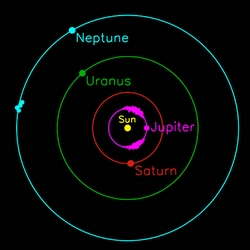[/caption]
A planetesimal is an object formed from dust, rock, and other materials. The word has its roots in the concept infinitesimal, which indicates an object too small to see or measure. Planetesimals can be anywhere in size from several meters to hundreds of kilometers. The term refers to small celestial bodies formed during the creation of planets. One way to think of them is as small planets, but they are much more than that.
The planetesimal theory was suggested by the Russian astronomer Viktor Safronov. The planetesimal theory is a theory on how planets form. According to the planetesimal hypothesis, when a planetary system is forming, there is a protoplanetary disk with materials from the nebulae from which the system came. This material is gradually pulled together by gravity to form small chunks. These chunks get larger and larger until they form planetesimals. Many of the objects break apart when they collide, but some continue to grow. Some of these planetesimals go on to become planets and moons. Since the gas giants are balls of gas with liquid cores, it may seem impossible that an asteroid-like object formed them. The planetesimals formed the core of these gaseous planets, which turned molten when it enough heat was created.
Other planetesimals turn into comets, Kuiper Belt Objects (KBOs), and trojan asteroids. There is some debate as to whether KBOs and asteroids can be called planetesimals. This is one reason why nomenclature of celestial objects is so difficult. The planetesimal theory is not universally accepted though. Like many theories, there are some observations that cannot be explained, but the planetesimal theory is still very popular.
Many people think that around 3.8 billion years ago, many of the planetesimals were thrown into far away regions, such as the Oort cloud or the Kuiper Belt. Other objects collided with other objects after being affected by gas giants. Phobos and Deimos are believed to be planetesimals that were captured by Mars’ gravity and became satellites. Many of Jupiter’s moons are believed to be planetesimals as well.
Planetesimals are very valuable to scientists because they can provide information about the creation of our Solar System. The exterior of planetesimals have been bombarded with solar radiation, which can change their chemistry, for billions of years. Inside though, there is material that has been untouched since the object was first formed. Using this material, astronomers hope to learn about the condition of the nebulae from which our Solar System was formed.
Universe Today has a number of articles to check out including formation of Mercury and hunting for meteors on Earth.
Check out NASA’s Solar System exploration page and NASA’s articles on formation of planetesimals in a nebula.
Astronomy Cast has an episode on how old the universe is.
Reference:
Wikipedia

